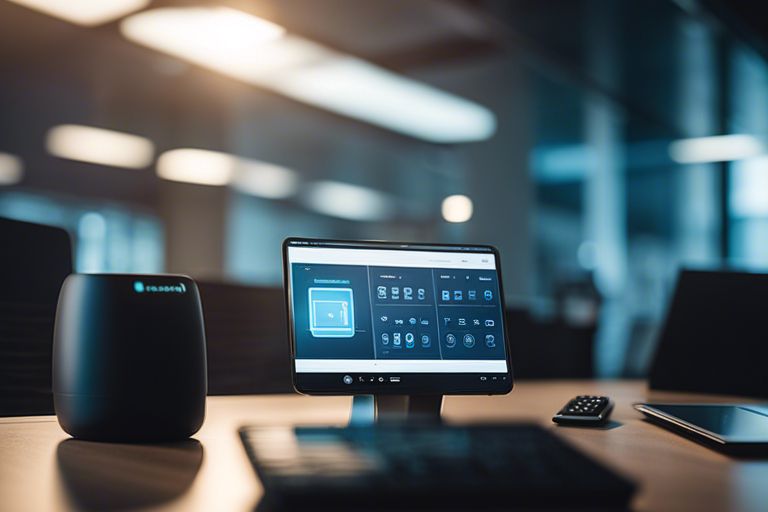Digital Transformation is revolutionizing industries, but integrating IoT devices amidst these changes can be a daunting task. To successfully navigate this complex process, organizations must implement strategic and thoughtful approaches. From ensuring data security to leveraging analytics for actionable insights, this blog post dives into key strategies for seamlessly incorporating IoT devices into digital transformation efforts.

Key Takeaways:
- Start with a clear strategy: Before integrating IoT devices into digital transformation efforts, it’s crucial to have a well-defined strategy that aligns with the overall goals of the organization.
- Focus on data integration: Ensuring seamless data integration from IoT devices into existing systems is key to deriving valuable insights and optimizing operations.
- Address security concerns: Prioritize implementing robust security measures to safeguard IoT devices and the data they collect, given the cybersecurity risks associated with IoT.
- Embrace scalability: Plan for scalability from the outset to accommodate the growing number of IoT devices and data volumes as the digital transformation progresses.
- Continuous monitoring and optimization: Regularly monitoring IoT devices, data flow, and performance metrics is crucial for identifying areas for improvement and ensuring the success of digital transformation efforts.
Defining IoT Devices and Digital Transformation
What are IoT Devices?
For a successful integration of IoT devices in digital transformation efforts, it is crucial to understand what IoT devices are. IoT devices, or Internet of Things devices, are physical gadgets embedded with sensors, software, and other technologies that connect and exchange data with other devices or systems over the Internet. These devices can range from smart thermostats and wearable fitness trackers to industrial machinery and autonomous vehicles.
What is Digital Transformation?
For a seamless incorporation of IoT devices into your digital transformation initiatives, a clear grasp of digital transformation is important. Digital transformation is the process of utilizing digital technologies to create new or modify existing, business processes, culture, and customer experiences to meet changing business and market requirements. It involves a fundamental shift in how organizations operate and deliver value to customers in today’s digital age.
The rapid pace of technological advancements and evolving consumer expectations have made digital transformation a necessity for businesses looking to stay relevant and competitive in the modern landscape. Organizations that embrace digital transformation can streamline operations, enhance customer engagement, and drive innovation.
Identifying Business Goals and Objectives
Aligning IoT Integration with Business Strategy
One of the crucial steps in successfully integrating IoT devices into digital transformation efforts is aligning them with your business strategy. By ensuring that IoT implementation supports your overall business goals, you can maximize the benefits and ROI of your IoT investments. This alignment involves identifying how IoT technologies can improve existing processes, create new revenue streams, enhance customer experiences, or optimize operations.
Determining Key Performance Indicators (KPIs)
Business success relies on clear metrics that measure progress toward goals. When integrating IoT devices, it is vital to determine Key Performance Indicators (KPIs) that align with your business objectives. These KPIs could focus on operational efficiency, cost reduction, customer satisfaction, or revenue growth. Defining relevant KPIs will help monitor the success of your IoT initiatives and make data-driven decisions to drive business outcomes.
With clearly defined KPIs, organizations can track the impact of IoT integration on key business metrics. Whether it’s measuring the productivity gains from automated processes or the cost savings from predictive maintenance, having defined KPIs provides a roadmap for assessing the effectiveness of IoT implementations.
Assessing Current Infrastructure and Capabilities
Evaluating Network and System Readiness
After deciding to integrate IoT devices into your digital transformation efforts, it is crucial to assess your current network and system capabilities. Ensuring that your network infrastructure can handle the increased data flow from these devices is vital. Bandwidth, latency, security protocols, and scalability must be evaluated to determine if any upgrades or changes are necessary. By conducting a comprehensive assessment, you can proactively address any potential issues that may arise during the integration process.
Identifying Gaps in Data Management and Analytics
To effectively leverage the data generated by IoT devices, it is imperative to evaluate your current data management and analytics capabilities. Evaluating your organization’s ability to collect, store, analyze, and act upon data can uncover any gaps that need to be addressed. Having a robust data strategy in place is key to extracting valuable insights and making informed decisions based on the data collected.
Evaluating Infrastructure Gaps
Infrastructure plays a critical role in the successful integration of IoT devices. Identifying any weaknesses or vulnerabilities in your current infrastructure is crucial to prevent potential disruptions or security breaches. Investing in the necessary upgrades or enhancements to fill these gaps can help ensure a smooth and secure IoT integration process.
Developing a Comprehensive Integration Plan
Not all IoT device integration efforts are created equal. To ensure a successful digital transformation, organizations must develop a comprehensive integration plan that outlines the steps, responsibilities, and protocols needed to seamlessly incorporate IoT devices into existing systems. This plan serves as a roadmap for the organization, guiding them through the complexities of integrating diverse devices and technologies.
Creating a Roadmap for IoT Device Integration
An imperative component of developing a comprehensive integration plan is creating a roadmap for IoT device integration. This roadmap should outline the specific devices to be integrated, the timeline for integration, and the key milestones to track progress. By establishing a clear roadmap, organizations can effectively manage the integration process, identify potential roadblocks, and ensure that all stakeholders are aligned on the integration goals.
Establishing Clear Roles and Responsibilities
Device integration can be a complex undertaking that involves multiple stakeholders across different departments. To streamline the integration process, organizations must establish clear roles and responsibilities for each team member involved. This ensures that everyone understands their tasks, deadlines, and the overall objectives of the integration effort. Clear communication and accountability are crucial for successfully integrating IoT devices into existing systems.
Integration efforts involving IoT devices can be challenging due to the diverse skill sets and knowledge required from various teams. By clearly defining roles and responsibilities, organizations can reduce confusion and inefficiencies, ultimately leading to a smoother integration process and better outcomes for the digital transformation initiative.
Defining Data Governance and Security Protocols
Integration of IoT devices brings with it a myriad of data governance and security concerns. Organizations must define robust protocols for data management, access control, and cybersecurity to protect sensitive information and ensure compliance with regulations. By clearly defining these protocols, organizations can mitigate the risks associated with IoT device integration and build trust with customers and partners.
Protocols around data governance and security are crucial for the success of IoT device integration efforts. These protocols should be regularly reviewed and updated to adapt to evolving threats and regulatory requirements, ensuring that the organization’s data remains secure and compliant at all times.
Understanding the importance of developing a comprehensive integration plan is key to the success of digital transformation efforts involving IoT devices. By following these strategies and best practices, organizations can navigate the complexities of device integration more effectively and drive successful digital transformations.

Selecting the Right IoT Devices and Partners
Despite the vast array of IoT devices available on the market, selecting the right ones for your digital transformation efforts is crucial for success. With so many options to choose from, it can be overwhelming to determine which devices will best suit your specific needs and goals. By evaluating the different IoT device options and vendors, you can ensure that you are making informed decisions that align with your objectives.
Evaluating IoT Device Options and Vendors
Selecting the most appropriate IoT devices and vendors requires a thorough evaluation of factors such as compatibility, reliability, scalability, security, and cost. It is necessary to carefully consider how each device will integrate with your existing systems and processes, as well as how well it can adapt to future technological advancements. By conducting in-depth research on various IoT vendors and their track records, you can mitigate the risks associated with choosing the wrong devices.
Choosing the Right Partners for Integration and Support
Right partners for integration and support play a key role in the success of your IoT implementation. When selecting partners to work with, consider factors such as their experience, expertise, responsiveness, and willingness to collaborate closely with your team. Collaborating with the right partners can help streamline the integration process, provide valuable insights and guidance, and ensure that your IoT devices function seamlessly within your digital ecosystem.
Evaluating potential partners through interviews, references, and case studies can give you a clearer understanding of their capabilities and how they align with your organization’s needs. Additionally, establishing clear communication channels and expectations with your partners can help facilitate successful integration and ongoing support for your IoT devices.
Implementing and Testing IoT Devices
Deploying IoT Devices and Integrating with Existing Systems
To successfully integrate IoT devices into digital transformation efforts, organizations must carefully plan their deployment and integration with existing systems. Once again, collaboration between IT and operational teams is crucial to ensure a smooth implementation process. To begin, organizations should conduct a thorough assessment of their current systems and infrastructure to identify potential integration points for IoT devices.
Conducting Thorough Testing and Quality Assurance
Implementing IoT devices without comprehensive testing and quality assurance can lead to operational failures and security vulnerabilities. Testing IoT devices for functionality, compatibility, and scalability is vital to ensure they perform as intended in the broader digital ecosystem. Organizations should establish rigorous testing protocols that include both simulated and real-world scenarios to validate the reliability and performance of IoT devices.
Another critical aspect of conducting thorough testing and quality assurance is assessing the security vulnerabilities of IoT devices. Organizations must employ penetration testing, vulnerability assessments, and security audits to identify and mitigate potential risks. It is imperative to prioritize security during the testing phase to protect sensitive data and prevent cyber attacks.
Addressing Technical and Security Challenges
Conducting regular audits and updates to address technical and security challenges is vital for maintaining the integrity of IoT devices in digital transformation initiatives. Organizations should stay informed about emerging threats and technological advancements to proactively adapt their security measures. It is crucial to collaborate with cybersecurity experts and leverage specialized tools to address vulnerabilities and ensure the resilience of IoT devices against evolving threats.
Monitoring and Optimizing IoT Device Performance
Now, successful integration of IoT devices in digital transformation efforts relies heavily on monitoring and optimizing their performance. By implementing effective strategies to track and enhance the performance of IoT devices, businesses can ensure a smooth and efficient operation of their interconnected systems.
Establishing Real-time Monitoring and Analytics
Analytics play a crucial role in establishing real-time monitoring of IoT devices. Leveraging advanced analytics tools allows businesses to gather and analyze data generated by IoT devices in realtime, providing valuable insights into device performance and operational efficiency. By monitoring key metrics such as device uptime, data transmission speed, and energy consumption, businesses can proactively identify and address potential issues before they escalate.
Identifying Areas for Improvement and Optimization
Identifying areas for improvement and optimization is vital for enhancing the overall performance of IoT devices. Through comprehensive data analysis, businesses can pinpoint bottlenecks, inefficiencies, and areas of underperformance within their IoT ecosystem. This information enables organizations to implement targeted strategies to optimize device performance, improve reliability, and enhance user experience.
Real-time monitoring and analysis of IoT devices allow businesses to stay agile and responsive to changing conditions. By continuously monitoring performance metrics and analyzing data in real time, organizations can quickly identify and address emerging issues, optimize device configurations, and fine-tune operational processes to maximize efficiency.
Continuously Refining and Enhancing IoT Device Performance
An ongoing effort to refine and enhance IoT device performance is crucial for ensuring long-term success in digital transformation initiatives. By continuously collecting and analyzing data, businesses can identify trends, patterns, and opportunities for enhancing the capabilities of their IoT devices. This iterative process of refinement and enhancement enables organizations to stay ahead of the curve, adapt to evolving technology trends, and drive innovation within their operations.
To wrap up
Now that we’ve explored strategies for successfully integrating IoT devices in digital transformation efforts, it’s clear that careful planning, stakeholder engagement, security considerations, and a focus on data management are crucial for a smooth implementation process. The insights and tips provided in this article can serve as a practical guide for businesses looking to leverage IoT technology effectively in their digital transformation journey. For more in-depth information on IoT implementation for businesses, check out the IoT Implementation Guide for Businesses: Navigating the…
FAQ
Q: Why is it important to integrate IoT devices in digital transformation efforts?
A: Integrating IoT devices in digital transformation efforts allows businesses to collect real-time data, improve operational efficiency, enhance customer experiences, and stay ahead of competitors in today’s digital world.
Q: What are some key strategies for successfully integrating IoT devices?
A: Some key strategies include conducting a thorough assessment of business needs, selecting the right IoT devices based on these needs, ensuring data security and privacy measures are in place, and integrating IoT solutions with existing systems seamlessly.
Q: How can businesses ensure a smooth transition when integrating IoT devices?
A: To ensure a smooth transition, businesses should provide proper training to employees, collaborate with IoT vendors and experts, create a detailed implementation plan, continuously monitor and evaluate IoT performance, and be open to making necessary adjustments along the way.
Stay tuned for more insights and tips on navigating visit our homepage for more articles.
